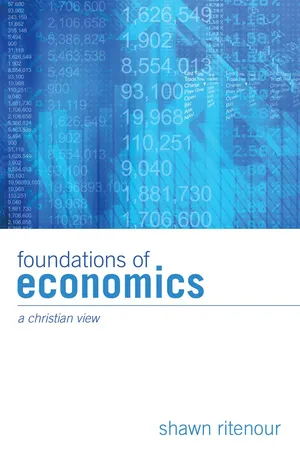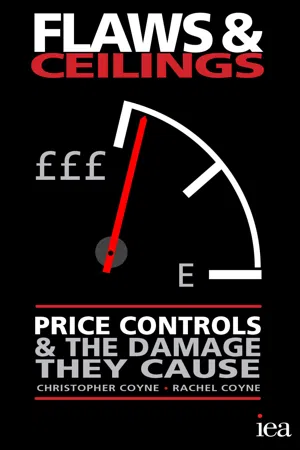Economics
Price Ceiling Effects
A price ceiling is a government-imposed limit on how high a price can be charged for a product or service. The effects of a price ceiling can include shortages of the product or service, reduced quality, and the emergence of black markets. Additionally, price ceilings can lead to inefficiencies in the allocation of resources.
Written by Perlego with AI-assistance
Related key terms
5 Key excerpts on "Price Ceiling Effects"
- eBook - ePub
Foundations of Economics
A Christian View
- Ritenour(Author)
- 2010(Publication Date)
- Wipf and Stock(Publisher)
ineffective . Typically, those words are taken to mean that something either works well or does not. In our case, however, the terms refer to whether the price ceiling has an effect on the actual price that buyers pay and sellers receive in an exchange. An effective price ceiling hampers voluntary exchange from negotiating a market price. An ineffective price ceiling is one that has no effect on the price that is charged and received in the market.A price ceiling is effective if the maximum legal price is less than the market price. An effective price ceiling is illustrated in the graph in figure 15.1. Figure 15.1. An effective price ceiling is a maximum legal price fixed below the market price. It always results in a shortage.As can be seen, if the government enacts a price ceiling P C that is below the market price P Mkt the market will not clear. We know this by identifying the quantity demanded and supplied at the ceiling price. Remember that the demand curve tells us the maximum quantity buyers will buy at any given price. Consequently, if we trace a horizontal line from the price axis at P C to the demand curve, we see that the quantity demanded is Q D . Likewise, the supply curve tells us the maximum quantity sellers are willing to sell at any given price. If we follow the same horizontal price line to the supply curve, we see that the quantity supplied at the price ceiling is Q S . We can determine the state of the market by comparing the quantity supplied with the quantity demanded.Because the price ceiling is below the market clearing price, the quantity demanded is greater than the quantity supplied. Chapter 5, in dealing with price determination, illustrated that this is a case of excess demand. Excess demand results in frustrated buyers because there are some buyers who are willing to buy the good at that price but cannot because there is not enough supplied by sellers. In a free market, this excess demand withers away as the more eager buyers bid up the price until everyone who wants to buy can buy. This occurs at the market price, the price at which quantity supplied equals quantity demanded. - No longer available |Learn more
Contemporary Economics
An Applications Approach
- Robert Carbaugh(Author)
- 2016(Publication Date)
- Routledge(Publisher)
- Why did many U.S. colleges rapidly increase tuition fees in the early 2000s?
- Why did the Pittsburgh Pirates roll back ticket prices in 2002?
- What factors explain an increase or decrease in the total revenue of the U.S. Postal Service following a rate increase?
Price Ceilings And Price Floors
Having learned about the reaction of consumers to price changes, let us next consider the issue of fairness. Occasionally, government officials feel that the forces of demand and supply result in prices that are unfairly low to sellers or unfairly high to buyers. Government may enact price controls to address these problems. When government imposes a price ceiling on a product, it establishes the maximum legal price a seller may charge for that product. Conversely, government may establish a price floor to prevent prices from falling below the legally mandated level. Let us analyze the effects of government price controls on individual markets.Rent Controls Make Housing More Affordable
Rent controls have been used in more than 200 U.S. cities, including New York, Boston, San Francisco, and Washington, D.C. The objective is to protect low-income households from escalating rents caused by perceived housing shortages and to make housing more affordable to the poor. By the late 1990s, however, many cities had cut back their rent-control measures because of the de-escalation of rent inflation and the public’s receptiveness to free-market economics applied to housing.The economic effects of rent controls are illustrated in Figure 3.2 . Assume initially that the equilibrium rent for a 2-bedroom apartment in New York City equals $600 per month, shown by the intersection of the market supply curve (S0 ) and the market demand curve (D0 - eBook - ePub
- Neva Goodwin, Jonathan M. Harris, Julie A. Nelson, Pratistha Joshi Rajkarnikar, Brian Roach, Mariano Torras(Authors)
- 2018(Publication Date)
- Routledge(Publisher)
But in other cases, especially where elasticity of supply is high, price controls can be disastrous. One example is in Zimbabwe, where extensive price controls were imposed in 2007 with the goal of keeping prices for food and other essential goods low. As our example leads us to expect, the result of enforced low prices was to destroy the incentive for farmers and other suppliers to produce, leading to severe shortages. So, the poor people whom the policy was supposed to help were instead hurt by unavailability of food and other basic goods, while farmers and other merchants were forced into bankruptcy. The price controls had to be abandoned after they forced the economy into virtual collapse.4.3 Price FloorsGovernments also sometimes intervene in markets with the opposite goal—to keep prices from falling to the market equilibrium. A price set above the market price is called a price floor or price support (because it establishes a minimum allowable price).price floor: a regulation that specifies a minimum price for a particular productWhy would governments want to keep prices at higher levels? The obvious reason is to aid producers. In the agricultural sector, price supports are common. Governments commonly specify minimum prices for agricultural products such as grain or milk. The goal is to help farmers, who often have considerable political influence. Of course, this also pushes up prices to consumers.The economic effect is the opposite of a price ceiling. Rather than creating a shortage, price floors create a surplus , as producers increase their output to take advantage of profitable higher prices. But these higher prices cause consumers to cut back their purchases. In some cases the government will buy up the surplus created by the price floor. From an economic point of view, this is clearly inefficient, because it encourages excess production and involves both higher prices to consumers and large government expenditures. Generally, economists would recommend a more efficient approach of giving direct aid to farmers if this is considered necessary, but leaving market prices alone.Another classic example of a price floor is the minimum wage. Most governments have minimum wage laws specifying that hourly wages must be at least a given level. The United States has a federal minimum wage of $7.25 per hour (as of 2017), although about 30 states have set higher minimum wage rates. Most other developed countries have higher minimum wage rates. For example, the minimum wage is equivalent to about $8/hour in Canada, about $11/hour in France, and $13/ hour in Australia.6 - eBook - ePub
- Neva Goodwin, Jonathan M. Harris, Julie A. Nelson, Pratistha Joshi Rajkarnikar, Brian Roach, Mariano Torras(Authors)
- 2022(Publication Date)
- Routledge(Publisher)
But in other cases, especially where the elasticity of supply is high, price controls can be disastrous. One example is in Zimbabwe, where extensive price controls were imposed in 2007 with the goal of keeping prices for food and other essential goods low. As our example leads us to expect, the result of enforced low prices was to destroy the incentive for farmers and other suppliers to produce, leading to severe shortages. So, the poor people whom the policy was supposed to help were instead hurt by the unavailability of food and other basic goods. Meanwhile, farmers and other merchants were forced into bankruptcy. The price controls had to be abandoned after they forced the economy into virtual collapse.4.3 Price Floors
Governments also sometimes intervene in markets with the opposite goal—to keep prices from falling to the market equilibrium. A price set above the market price is called a price floor or “price support” (because it establishes a minimum allowable price).price floor: a regulation that specifies a minimum price for a particular productWhy would governments want to keep prices at higher levels? The obvious reason is to aid producers. Governments commonly specify minimum prices for agricultural products such as grain or milk. The goal is to help farmers, who often have considerable political influence. Of course, this also pushes up prices to consumers.The economic effect is the opposite of a price ceiling. Rather than creating a shortage, price floors tend to create a surplus, as producers increase their output to take advantage of profitable higher prices. But these higher prices cause consumers to cut back their purchases. In some cases, the government will buy up the surplus created by the price floor. From an economic point of view, this is clearly inefficient, because it encourages excess production and involves both higher prices to consumers and large government expenditures. Generally, economists would recommend a more efficient approach of giving direct aid to farmers, if this were considered necessary, but leaving market prices alone.Another classic example of a price floor is the minimum wage. Most governments have minimum wage laws specifying that hourly wages must be at least a given level. The United States has a federal minimum wage of $7.25 per hour (as of 2022), although about 30 states have set higher minimum wage rates. Most other developed countries have higher minimum wage rates. For example, the minimum wage is equivalent to about $10 per hour in Canada, about $11 per hour in France, and $15 per hour in Australia.6 - eBook - ePub
Flaws and Ceilings
Price Controls and the Damage They Cause
- Christopher Coyne, Rachel Coyne, Philip Booth, Ryan Bourne, Stephen Davies, Robert Miller, Colin Robinson, Steven Schwartz, W. Stanley Siebert, Christopher Snowdon, Richard Wellings(Authors)
- 2015(Publication Date)
- London Publishing Partnership(Publisher)
8. Price ceilings in financial markets
Philip Booth and Stephen DaviesControls and ceilings on the quantity and cost of credit are probably the oldest form of price control. They are also among the most damaging. Often, as in the Islamic world or classical Greece, the very idea of lending money with interest attached is condemned as unnatural or impious. This was also, of course, the position of early Christians. However, so great is the need for credit in any functioning economy beyond subsistence level that, in practice, lending at interest still happens no matter what the theologians and philosophers may argue. What tends to happen, as with the medieval anti-usury laws, is that a ban on ‘excessive’ interest substitutes for a ban on all interest. In other words, there is a ceiling set on the level of interest that may be charged for a loan. This is quite simply a price cap and, like all such caps, it has economically damaging and disruptive effects.Moreover, because of the central role of money in exchange and in economic activity in general, and given the central place of credit in facilitating growth and innovation, price ceilings on credit have impacts that are more extensive and harmful than those imposed on other aspects of economic life. In particular, because for every debtor there is also a creditor, interest rate caps have far reaching impacts on investment returns in general. As well as being a limit on charges to borrowers, they necessarily limit returns to certain kinds of investment and, indirectly, some or most kinds of savings.The most common form of interest ceiling is a cap on the level or amount of interest that can be charged to a borrower. Sometimes, limitations of this kind are imposed in general, on all kinds of loans and credit and on all borrowers, as for example during the Middle Ages in Europe (at least in theory). More often, caps are imposed on specific kinds of loan or credit. In these cases the restrictions are typically applied to credit products that are disproportionately used – or thought to be used – by people on low or irregular incomes. The usual goal of a ceiling on interest is to protect borrowers on low incomes from the consequences of their own lack of financial literacy (i.e. an information asymmetry). However, this intention is usually portrayed as being a matter of protecting low-income borrowers against so-called ‘predatory’ lenders.
Index pages curate the most relevant extracts from our library of academic textbooks. They’ve been created using an in-house natural language model (NLM), each adding context and meaning to key research topics.




